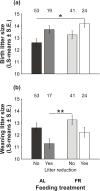Pre-breeding food restriction promotes the optimization of parental investment in house mice, Mus musculus
- PMID: 28328991
- PMCID: PMC5362082
- DOI: 10.1371/journal.pone.0173985
Pre-breeding food restriction promotes the optimization of parental investment in house mice, Mus musculus
Erratum in
-
Correction: Pre-breeding food restriction promotes the optimization of parental investment in house mice, Mus musculus.PLoS One. 2017 May 26;12(5):e0178804. doi: 10.1371/journal.pone.0178804. eCollection 2017. PLoS One. 2017. PMID: 28552990 Free PMC article.
Abstract
Litter size is one of the most reliable state-dependent life-history traits that indicate parental investment in polytocous (litter-bearing) mammals. The tendency to optimize litter size typically increases with decreasing availability of resources during the period of parental investment. To determine whether this tactic is also influenced by resource limitations prior to reproduction, we examined the effect of experimental, pre-breeding food restriction on the optimization of parental investment in lactating mice. First, we investigated the optimization of litter size in 65 experimental and 72 control families (mothers and their dependent offspring). Further, we evaluated pre-weaning offspring mortality, and the relationships between maternal and offspring condition (body weight), as well as offspring mortality, in 24 experimental and 19 control families with litter reduction (the death of one or more offspring). Assuming that pre-breeding food restriction would signal unpredictable food availability, we hypothesized that the optimization of parental investment would be more effective in the experimental rather than in the control mice. In comparison to the controls, the experimental mice produced larger litters and had a more selective (size-dependent) offspring mortality and thus lower litter reduction (the proportion of offspring deaths). Selective litter reduction helped the experimental mothers to maintain their own optimum condition, thereby improving the condition and, indirectly, the survival of their remaining offspring. Hence, pre-breeding resource limitations may have facilitated the mice to optimize their inclusive fitness. On the other hand, in the control females, the absence of environmental cues indicating a risky environment led to "maternal optimism" (overemphasizing good conditions at the time of breeding), which resulted in the production of litters of super-optimal size and consequently higher reproductive costs during lactation, including higher offspring mortality. Our study therefore provides the first evidence that pre-breeding food restriction promotes the optimization of parental investment, including offspring number and developmental success.
Conflict of interest statement
Figures









References
-
- Roff DA. Life history evolution. 1st ed. Sunderland: Sinauer Associates; 2001.
-
- Charnov EL. Evolution of mammal life histories. Evol Ecol Res. 2001; 3: 521–535.
-
- Pianka ER. Natural selection of optimal reproductive tactics. Am Zool. 1976; 16: 775–784.
MeSH terms
LinkOut - more resources
Full Text Sources
Other Literature Sources

